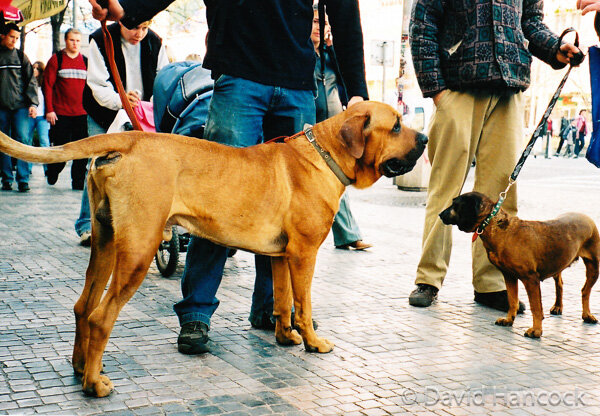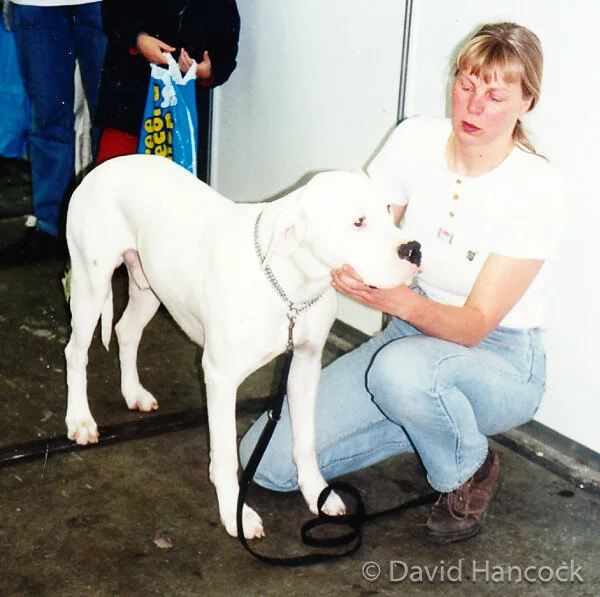1076
LOOKING AGAIN AT BANNED BREEDS
By David Hancock
Half a century ago, after a number of horrific attacks by dogs on people, some of them young children, there was a press outcry against so-called 'devil-dogs' and press campaigns for bans and other government action. In due course the Home Office consulted two bodies, one with responsibility for animal welfare and the other responsible for recognised breeds of dog, respectively the RSPCA and the Kennel Club. The eventual outcome was the Dangerous Dogs Act that, amongst other measures, banned 4 breeds of dog from the UK: the Pit Bull Terrier, the Japanese Tosa, the Fila Brasileiro and the Dogo Argentino. This was heralded by the national press as at least a step forward. But it was nothing of the kind. Firstly these two consultative bodies had no experience or knowledge of these breeds; secondly there was no evidence linking the latter three breeds with dog attacks on humans and thirdly, these three breeds were the national breeds of their respective countries, with the Brazilian dog the most temperament-tested breed in the world. The Japanese Tosa was used in regrettable and unseemly dog v dog combat but this was more ceremonial than ferocious and resembled muzzle-wrestling more than dog fighting.
The Pit Bull Terrier ban was the hardest to impose. There were no Tosas, Filas or Dogos in the UK - the KC didn't even recognise them as a breed. But breed identification of Pit Bulls and Pit Bull type brought difficulties, mainly because our own Staffordshire Bull Terriers, especially coarsely-bred ones, closely resembled the Pit Bull type. In often ludicrous attempts to associate anatomy with unstable temperament, the police, sadly led by the Metropolitan force, set themselves up as 'experts' in identifying this undesired type, leading to thousands of perfectly innocent dogs being destroyed. Any Staffie enthusiast striving to keep his pet fit on suspended car-tyres or weight-pulling apparatus came under suspicion of 'having equipment designed for dog-fight training' with dogs and apparatus being seized. There were however no curbs, such as licences, placed upon the breed of Staffordshire Bull Terrier, despite one of the breed's KC-exhibitors being convicted of dog-fighting charges.
In the mid-1990s I found myself sitting at a luncheon next to the former minister at the Home office when this Act was being drafted and then passed into law. He was now a minister in a different department. It was quite clear, without breaching the confidentiality of this conversation, that he felt badly advised and regretted the basis on which the Act was worded. As the Act clearly has not worked - dog attack rates have remained the same - the minister's after-thoughts are well-founded. Organised dog-fighting in the UK has long been banned and regarded with revulsion by the general public. But the breeding of Staffordshire Bull Terriers and their variants, often called 'Irish Staffies', has never been controlled by licence, even if just to protect the dogs from ill-considered breeding in back-street pens. Despite dog-fighting being a village sport in countries like Afghanistan, imports from there have never been scrutinised, with one charity in Britain specialising in rehoming strays and disowned dogs from Afghanistan, some of which may have featured in dog fighting contests. This undermines the little good this Act may have done. In far too many countries of the world, legislators are struggling to find legal means of controlling dangerous dogs.
The menace of powerful savage dogs to innocent people, especially children, has to be countered. But perhaps because a demented dog can inflict such appalling injuries, the reaction to this menace has been extreme, irrational, too hasty, over-reactive and, as far as justice is concerned, unfair. In Ireland the following breeds were listed as dangerous: the Pit Bull Terrier, the Bulldog, the Bullmastiff, the Dobermann, the Bull Terrier, the German Shepherd Dog, the Japanese Akita and Tosa, the Rhodesian Ridgeback, the Rottweiler and the Staffordshire Bull Terrier. In North America, most of these breeds have been banned or restricted in various places but so too have the Labrador and Golden Retrievers, the English Springer Spaniel, the Boxer, the Great Dane, the Airedale, the Chow Chow and the little Pug.
In North Bergen, New Jersey, all dogs with short hair, a muscular build, weighing between 20 and 125 pounds and of any colour are unlawful. In Bavaria recently the Rhodesian Ridgeback has been banned as a breed after one incident involving one dog. Your breed could be the next to be proscribed, whatever your dog has done. Dog lovers in Britain are simply failing to appreciate the hit-or-miss, all-embracing capability of their own law. One RSPCA chief inspector in Britain has supported the prosecution of 64 crossbred dogs, all pets, not one of them accused of unwarranted aggression but all of them alleged to be "of pit bull type", whatever that is. The RSPCA seems to be defying its own name in going out of its way to activate this ill-considered legislation and they have now lost much of their financial support. But what on earth is "Pit Bull type"? To avoid banning, dogs bred as Pit Bull Terriers are now being advertised as Pompey Bull Terriers, Irish Bull Terriers, old English bull-and-terriers and Staffordshire bull-and-terriers. As a result many city councils in America have banned all cross-bred dogs from a bulldog/terrier mixture. What a commentary on breed-related legislation as a selective deterrent!
There is however in America a breed called the American Staffordshire Terrier (i.e. without 'bull' in the name) which comes from the very same foundation stock as the Pit Bull Terrier. This is a breed recognised by the American Kennel Club as pedigree and therefore has a breed standard. So, as the American Staffordshire and Pit Bull Terriers are genetically identical, the breed standard for the former and accepted by the AKC is a means of identification for the latter, if breeds are to have significance in law.
Pit Bull Terriers originated in America in the early 1800s from Irish, English, Spanish and Sicilian pit dogs imported to compete in organised dog-fighting. They tend to be 50lbs in weight, short-haired, strongly-muzzled, with the body of a Bull Terrier and the coat colours of the Bulldog, mainly brindle, red or tan. The head lacks the rugger-ball shape of the pedigree Bull Terrier and the sharper muzzle of the pedigree Staffordshire Bull Terrier. In the last ten years in the USA, Pit Bull Terriers have caused 20 of the 28 human deaths due to dog bites. But, nearly all these dogs were owned by people wishing to project a "macho" image and misusing their dogs to express their own hostility to society. They could (and one day soon probably will) have chosen another breed. As a result of the isolated antisocial moronic behaviour of a relatively tiny group of misfits, thousands of perfectly well-behaved dogs have lost their lives.
No rational person wants to possess a dangerous dog but laws passed to combat such a menace must be fair...and workable. Most dog bites on humans are not inflicted by the Bull Terrier types but by crossbred Collies, German Shepherd Dogs, Jack Russell Terriers and nondescript mongrels. If, like the DDA of 1991, you are banning breeds bred for fighting then, logically, you must ban the Staffordshire Bull Terrier and the Chinese fighting dog, the Shar Pei. So this law when applied defies its own wording. There is no evidence at all in the milliennia of the man-dog association of one or two demented dogs typifying a breed. There is overwhelming evidence to associate individual dog's behaviour with their owners or breeders.
In the United Kingdom, there are roughly eight million dogs - with less than half being registered as pedigree. There are therefore some three million dogs in this country which cannot be identified as belonging to a breed. They can only be identified by their association with a deed through eye-witness accounts, photographic evidence, etc. Why should not this system apply similarly to dogs from known breeding? A thousand perfectly well-behaved Pit Bull Terriers have already been destroyed because of the wording of the Dangerous Dogs Act. In other circumstances such activity would be called racial discrimination or even ethnic cleansing. The evidence in these cases is being provided by RSPCA officials and vets, professionals whose purpose in life is to prevent suffering in dogs - not in humans.
But the DDA is breed-related not breed-restricted; where is it going to end? Many pedigree breeds have a dog-fighting past: Bull Terriers, Staffordshire Bull Terriers, Chow Chows, Chinese Shar Peis, Japanese Tosas, Akitas, Irish Terriers, Bedlingtons and Kerry Blues. Ban one of these and the dog-fighting fraternity will produce a dog that looks unlike any of them. In Afghanistan dog fights take place using dogs like Tibetan mastiffs. In the last century in this country there were matches between "bantam terriers" in many rural areas. In Spain near Cordoba there were once organised fights between bull-baiting dogs. In medieval Russia huge bear-hunting dogs were made to fight each other. Banning a breed will never deter those determined to organise dog fights. Such an indiscriminate measure can only bring wholly needless destruction of the innocent. It may not be a matter of whether it is going to affect your breed but when.
It just needs one hitherto well-behaved breed to become favoured by an evil section of the community and then for abused dogs of that breed to escape and blindly attack the nearest member of the public, for a century of admirable behaviour to be forgotten and a ban imposed. Any breed can be added to those already banned under this act. There is no appeal. There is no rationale to be argued against; if the Home Office decides your breed is "dangerous" then every single member of that breed is automatically dangerous too. It is no good looking to the Kennel Club; they 'advised' the Secretary of State who drew up the act. It is no protection to have your dog registered with the KC. Registered dogs have already been destroyed.
It is no good going to the veterinary profession; there is no shortage of vets ready to go to court in order to support this act. It is no good going to the RSPCA; quite the reverse. Will you have time to lobby for your dog's life to be spared? You have time now however. There is only one humane way for dangerous dogs to be controlled and that is for dogs to be judged by their deeds not their breed. And if there is a psychopathic strain in any breed let us not shy away from removing it before a small child is disfigured. The present act fails to provide such protection, despite its promiscuous cover. Bad laws only get changed when a determined band of likeminded people apply sustained pressure and persevere. You may not be affected by this Act at the moment. Use that benefit of time. This act is not flawed in its intention but in its application. Change "breed" to "deed" and a new concept is introduced. Do nothing and your breed's time may come! Truly dangerous dogs should die if innocent breeds are to survive.












